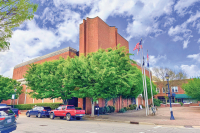Oil lamps have long history of lighting the way
 Surprisingly, a recent column about wood-burning cookstoves attracted as much attention as anything I’ve written for years. Folks who live in The Smoky Mountain News distribution area and can pick up the print edition were the most numerous e-mail correspondents, of course. But a lot of people outside of the region must read the publication online as well because at least 10 people living in different parts of the country contacted me to reminisce about their woodstove experiences.
Surprisingly, a recent column about wood-burning cookstoves attracted as much attention as anything I’ve written for years. Folks who live in The Smoky Mountain News distribution area and can pick up the print edition were the most numerous e-mail correspondents, of course. But a lot of people outside of the region must read the publication online as well because at least 10 people living in different parts of the country contacted me to reminisce about their woodstove experiences.
None of the people here or abroad had anything but pleasant memories. None seemed to recall the days when the chimney smoked or there was no dry wood ... or no wood at all. They remembered grandma baking bread or a Thanksgiving turkey baking in the oven or canning vegetables in the fall. Several reported they are still using wood-burning cookstoves, at least on a part-time basis, but for most, they are a part of the nostalgic past. Best of all, two people said they liked my “Woodstove” poem.
So coming up with the topic for this week’s column was a no-brainer. As with cookstoves, Elizabeth and I have been lighting our home with oil lamps for 30 years. Are there people out there who are nostalgic about oil lamps? I’m betting on it.
The story oft how we first started using woodstoves and oil lamps is both complicated and boring, so I’ll spare you the details. Using them isn’t a big deal. Lots of folks living in the Smokies region today grew up that way. And most folks today would much rather use electric or gas burners and switch on the electric lights. But in many ways that count our lives have been enhanced by doing the opposite.
I don’t know when the first oil lamps arrived here in the mountains. It must have been well before cast-iron wood-burning cookstoves arrived. And before lamps, of course, there was firelight and candle light.
About 20 years ago, I purchased in a used bookshop a little 45-page pamphlet by Cecil A. Matthews titled Discovering Oil Lamps. It was published in 1972 in England. Most of Discovering Oil Lamps is devoted to illustrations and descriptions of lamp types and paraphernalia. Most are various types of table lamps, including lamps mounted on arm extensions for reading. The floor lamps are very elegant. Harp lamps hang from the ceiling on short metal supports, whereas suspension lamps hang on extended chains. Bracket lamps are mounted on walls, some with swinging arms. One of the piano lamps is mounted on a gooseneck arm so that light could be reflected onto sheet music. Then there are various hand lamps used in the same manner as flashlights.
Related Items
We have found that the tinted kerosene mandated by the state several years ago is hopeless. We could barely light and keep our lamps going with that crud. We always go to one of the local stations selling K-1 fuel oil.
I have but one hard and fast rule regarding oil lamps. It’s called The Ellison Rule For Lamp Placement & Adjustment. Always position a lamp so that the wick adjustment mechanism is on the right side if you’re right-handed or on the left side if you’re left-handed. Doesn’t that make perfect sense? You just reach out and adjust the wick without having to first rearrange the lamp. Both Elizabeth and I are right-handed. It follows that all of the lamps in our home should be placed with adjustment mechanisms on the right side, doesn’t it? Does Elizabeth follow this rule? No. She almost invariably places them reversed so as to bother me.
Lamplight is a softly luminescent light. Our combined kitchen and sitting area comes to life once the lamps are lit. Many evenings at dusk I cross the bridge in front of our house and walk down into the pasture. Looking back across the creek, I can see blue woodsmoke spiraling upward from the chimney and the windows of our home glowing with lamplight.
Editor’s note: This column first appeared in The Smoky Mountain News in February 2003.
George Ellison wrote the biographical introductions for the reissues of two Appalachian classics: Horace Kephart’s Our Southern Highlanders and James Mooney’s History, Myths, and Sacred Formulas of the Cherokees. In June 2005, a selection of his Back Then columns was published by The History Press in Charleston as Mountain Passages: Natural and Cultural History of Western North Carolina and the Great Smoky Mountains. Readers can contact him at P.O. Box 1262, Bryson City, N.C., 28713, or at This email address is being protected from spambots. You need JavaScript enabled to view it..









